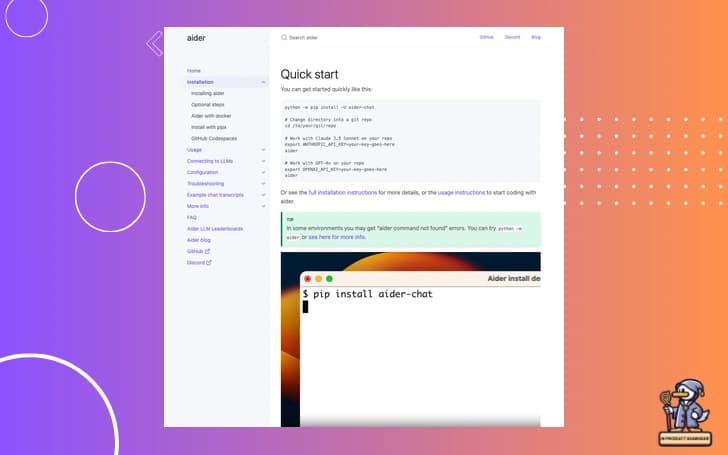🦆 QuackChat: The DuckTypers' Daily AI Update
Welcome back, DuckTypers! Jens here. Today, we'll explore the ethical debates surrounding deepfake technology, address AI performance limitations, discuss LM Studio's latest features, delve into NotebookLM improvements, and look at the new updates in Aider. Let's dive in.
🎭 Deepfake Technology Sparks Ethical Debate

I've been reading discussions about deepfake technology, and it's raising some serious ethical questions. Users are conflicted about its implications, especially when consent isn't clear.
For instance, in a recent conversation on the Notebook LM Discord, participants emphasized the importance of transparent consent, arguing that there's a lack of understanding among the general public about deepfakes.
From an engineering perspective, we need to consider how to implement transparent consent mechanisms. Perhaps we can design a system where content creators can embed metadata indicating their consent status.
What do you think? Feel free to share your thoughts in the comments.
🤖 AI Performance Limitations Noted

One of the challenges we've been observing in AI models is their tendency to hallucinate, especially when it comes to counting and mathematical accuracy. This issue has been a hot topic in the LM Studio community, where users have reported discrepancies during score counting. These limitations highlight a fundamental problem in how AI models handle numerical computations.
In a discussion on the LM Studio general chat, users noted that AI models often struggle with basic arithmetic operations, leading to incorrect results in tasks that require precise calculations.
Understanding the Issue
Large Language Models (LLMs) like GPT are designed to predict the next word in a sequence based on patterns learned from vast textual data. While they excel at generating coherent and contextually relevant text, they aren't inherently equipped for precise mathematical computations.
For example, consider the following interaction:
User: What is 257 plus 389?
AI Model: The sum of 257 and 389 is 546.
Here, the correct answer should be 646, but the AI model provides an incorrect result due to its lack of computational accuracy.
Engineering Perspective
From an engineering standpoint, relying solely on AI models for mathematical operations isn't reliable. To address this limitation, we can integrate external computational tools or functions that handle mathematical tasks accurately.
Proposed Solution: Hybrid AI Systems
By creating a hybrid system that combines the language understanding capabilities of AI models with the computational accuracy of programming functions, we can improve overall performance.
System Architecture Diagram
In this architecture:
- The AI Model processes the user input.
- It determines if the response requires a calculation.
- If yes, it invokes an external function to perform the computation.
- The final response is generated by combining the AI's output with the accurate calculation.
Example Implementation
Suppose we're building a chatbot that needs to handle mathematical queries.
Step 1: AI Model Processes Input
The AI model receives the user's question:
"What is the factorial of 5?"Step 2: AI Identifies Computational Requirement
The AI model recognizes that this requires a mathematical operation and generates a placeholder or a function call:
"To find the factorial of 5, we compute factorial(5)."Step 3: External Function Performs Calculation
We define a Python function to perform the factorial calculation:
def factorial(n):
if n == 0 or n ==1:
return 1
else:
return n * factorial(n - 1)Step 4: Integrate the Result
The system replaces the placeholder with the actual result:
"To find the factorial of 5, we compute factorial(5), which equals 120."Code Snippet
Here's how the integration might look in code:
import re
def factorial(n):
if n == 0 or n ==1:
return 1
else:
return n * factorial(n - 1)
def process_response(response):
# Regex to find 'factorial(number)'
match = re.search(r'factorial\((\d+)\)', response)
if match:
number = int(match.group(1))
result = factorial(number)
# Replace placeholder with actual result
return response.replace(f"factorial({number})", str(result))
else:
return response
# AI Model's output
ai_response = "To find the factorial of 5, we compute factorial(5)."
# Process the response
final_response = process_response(ai_response)
print(final_response)Output:
"To find the factorial of 5, we compute 120."Benefits of This Approach
- Accuracy: Ensures that all mathematical computations are correct.
- Efficiency: Offloads computational tasks to functions optimized for such operations.
- Scalability: Can handle a wide range of mathematical functions by adding more external methods.
Potential Challenges
- Complexity: Requires the AI model to correctly identify when to invoke external functions.
- Security Risks: Executing code based on AI outputs can be risky if not properly sanitized.
- Integration Overhead: Adding additional layers can increase the system's complexity.
Addressing Security Concerns
To mitigate security risks:
- Validate Inputs: Ensure that any parameters passed to functions are validated and sanitized.
- Limit Functionality: Restrict the set of functions that can be called to a predefined list.
- Use Sandboxing: Execute code in a secure, isolated environment.
Extending the Solution
This approach isn't limited to mathematical functions. It can be extended to:
-
Date and Time Calculations:
from datetime import datetime, timedelta def add_days(current_date, days): return current_date + timedelta(days=days) -
Data Retrieval:
import requests def get_weather(city): # Code to fetch weather data for the city pass
Real-World Application Example
Use Case: An AI assistant that helps with inventory management.
User Query:
"How many items do we have left in stock after selling 150 units today?"
AI Model Response:
"We started with inventory_count units. After selling 150 units, we have calculate_remaining_stock(inventory_count, 150) units left."
External Functions:
def calculate_remaining_stock(total, sold):
return total - sold
inventory_count = 500 # This could be retrieved from a database
# Processing the AI response
remaining_stock = calculate_remaining_stock(inventory_count, 150)
print(f"After selling 150 units, we have {remaining_stock} units left in stock.")Output:
"After selling 150 units, we have 350 units left in stock."Community Input
Have you implemented similar solutions in your projects? Integrating AI models with external functions can significantly enhance performance, but it also introduces new complexities.
- Share your experiences: What challenges have you faced?
- Best practices: Do you have recommendations for securely integrating code execution?
- Alternative Approaches: Are there other methods you've found effective in improving AI accuracy?
🛠️ LM Studio Feature Discussions

There have been conversations about LM Studio's feature requests and performance concerns with large models. Users are facing issues with model compatibility and GPU limitations.
Participants discussed the effectiveness of different models and their associated offloading capabilities when running large language models. It was noted that limited VRAM could significantly impact model performance and usability.
For more details, check out the discussion on the LM Studio Discord.
As a software architect, I see this as an opportunity to optimize resource management. Maybe implementing more efficient algorithms or supporting model quantization could help.
Are you using LM Studio? Share any tips or challenges you've encountered.
📚 NotebookLM Feedback and Improvements

Users are providing valuable feedback on NotebookLM, highlighting issues with audio uploads and data storage. The community is suggesting enhancements that could improve the overall experience.
For instance, users have reported difficulties uploading audio files from Android devices to NotebookLM, with issues specifically noted with the Media Picker and overall file accessibility. You can find more about this in the Notebook LM general channel.
Perhaps we can contribute by proposing solutions for file accessibility on different devices. Ensuring cross-platform compatibility is crucial.
What features would you like to see in NotebookLM? Your input could make a difference.
🆕 Aider v0.60.1 Updates and Integration with PearAI
The latest update of Aider, a powerful AI-assisted coding tool, introduces several new features, including support for Claude 3 models and enhanced command handling. Moreover, Aider is now integrated with PearAI Creator, providing developers with an even more robust coding assistant.
What is Aider?
Aider is an AI-powered tool that assists developers in writing, editing, and maintaining code. It leverages large language models (LLMs) to provide intelligent code suggestions, automate repetitive tasks, and improve overall coding efficiency.
Key Features of Aider v0.60.1

- Support for Claude 3 Models: Aider now supports Claude 3 models, enhancing its ability to understand and generate code.
- File Sorting: Improved file management with the ability to display filenames in sorted order.
- Fancy Input Flag: A new
--fancy-inputflag allows for better command handling, making interactions with Aider more seamless.
You can read the full release notes here.
Integration with PearAI Creator
PearAI, an open-source AI code editor, has integrated Aider into its platform through the PearAI Creator feature. This integration empowers PearAI users to leverage Aider's advanced code generation and editing capabilities directly within the PearAI environment.
About PearAI Creator
PearAI Creator can build apps, fix bugs, and implement new features automatically. With Aider integrated, it has full context of your codebase and the ability to create and edit multiple files simultaneously.
Getting Started with PearAI Creator

Here's how you can start using PearAI Creator with Aider:
-
Update or Install PearAI:
- If you already have PearAI installed, go to "Help" at the top menu and search for "Update" to get the latest version.
- If you're new to PearAI, download the latest version here.
-
Launch PearAI Creator:
- Open the command palette by pressing
CMD/CTRL + Shift + P. - Select "PearAI Creator" from the options.
- The first run may take a moment to install and initialize Aider. Subsequent runs will be quicker.
- Open the command palette by pressing
-
Start Coding:
- You can now ask for new features, bug fixes, or even start a new app.
- Aider, powered within PearAI, will assist you by generating code, making edits, and providing suggestions.
Example Workflow
Let's say you want to add a new feature to your app:
-
Invoke PearAI Creator:
- Open the command palette and select "PearAI Creator".
-
Describe Your Feature:
- Type in a prompt like, "Add a user authentication system with email verification."
-
Aider Gets to Work:
- Aider will analyze your existing codebase.
- It will generate the necessary code for the authentication system.
- Multiple files will be created or edited as needed.
-
Review and Test:
- Review the changes Aider has made.
- Test the new feature to ensure it works as expected.
Benefits of Using Aider with PearAI
- Contextual Understanding: Aider has full context of your codebase, leading to more accurate code generation.
- Multi-file Editing: It can create and edit multiple files simultaneously, streamlining development.
- Efficiency: Automates repetitive tasks, allowing you to focus on more complex aspects of development.
Troubleshooting and Support
PearAI Creator is currently in beta, so you might encounter some issues. Here are some troubleshooting tips:

- Aider Installation Issues:
- If PearAI Creator isn't responding, it might be due to Aider not being installed properly.
- Manually install Aider by following the instructions here.
- Ensure you can run
aiderorpython -m aiderin your terminal without errors.

- Further Assistance:
- If problems persist, reach out on the PearAI Discord channel for support.
Visual Overview
Here's a simplified diagram of how Aider integrates with PearAI Creator:
Use Case Example
Scenario: You have a Python project and want to refactor code for better performance.
-
Invoke PearAI Creator:
- Open the command palette and select "PearAI Creator".
-
Describe Your Request:
- "Optimize the data processing module to improve performance."
-
Aider's Actions:
- Analyzes the
data_processing.pymodule. - Identifies bottlenecks or inefficient code.
- Refactors code, perhaps by introducing list comprehensions or utilizing more efficient algorithms.
- Analyzes the
-
Result:
- Provides the updated
data_processing.pyfile. - Offers explanations for the changes made.
- Provides the updated
-
Review:
- You review the changes and test the module to verify performance improvements.
Aider's Contribution to Its Own Development
Interestingly, Aider has been instrumental in writing its own code. According to the release notes, Aider wrote 49% of the code in version 0.60.1 and up to 77% in previous releases. This showcases the power of AI-assisted development and how tools like Aider can accelerate software development.
Conclusion

The integration of Aider into PearAI Creator marks an exciting development in AI-assisted coding. By combining Aider's powerful code generation capabilities with PearAI's user-friendly environment, developers can significantly enhance their productivity.
Try it out for free: Visit trypear.ai to download PearAI and start leveraging Aider in your coding projects.
Have you experimented with Aider and PearAI Creator? Share your experiences and let us know how these tools have impacted your development workflow.
🚀 Final Thoughts
Today, we've explored the ethical debates surrounding deepfake technology and the importance of transparent consent mechanisms. We've addressed AI performance limitations like hallucinations and counting errors, considering solutions such as integrating reliable code for mathematical tasks. We discussed LM Studio's features and challenges, highlighting opportunities for optimization in resource management. We also delved into user feedback on NotebookLM, emphasizing the need for cross-platform compatibility, and examined the latest updates in Aider, including its integration with PearAI.
As we navigate these developments in AI, it's essential to approach them thoughtfully and collaboratively. Let's continue to learn and innovate from an engineering perspective.
Feel free to share your thoughts and experiences in the comments. Your insights are invaluable.
Thanks for joining me on QuackChat today. Until next time, keep exploring and happy coding!


